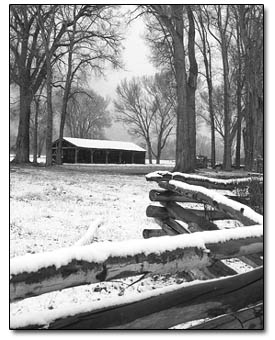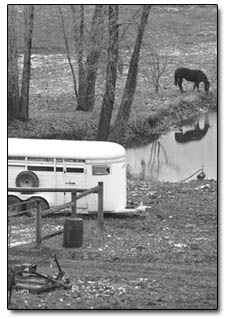|
County transferable development rights ordinance
drafted
 |
An empty stable gets a fresh blanket of
snow along County Road 250 recently. Under an ordinance being
drafted by the county, open space like this could be preserved
by developers in exchange for higher-density
development elsewhere in the county./Photo by Todd Newcomer. |
After more than a year of work, a potential antidote to sprawl
in La Plata County remains in limbo. However, efforts to create
an open space tool known as transferable development rights (TDRs)
are continuing to move forward, and there is hope of some resolution
by early next year.
On Oct. 20, 2002, La Plata County commissioners took a big breather
and voted to enter a moratorium on development in the Grandview
area. In one sense, the move was a response to the Southern Ute
Indian Tribe’s proposal to build more than 2,000 units on
vacant land east of Durango. In another sense, the moratorium
was enacted to give county staffers and a citizens’ working
group an opportunity to investigate TDRs as a way of preserving
open space before it is too late.
Sending and receiving
TDRs are the process by which property rights are purchased in
“sending areas,” places earmarked as vital open space.
Developers then take these rights to urban, “receiving areas”
where they have the opportunity to develop extra units in exchange.
The working group held its first meeting Nov. 13 of last year
and since that time has labored to determine whether a voluntary,
incentive-based TDR program would actually be effective in La
Plata County.
Tom Maynard, a Four Corners Planning and Design Group consultant
who is helping guide the process, explained: “The principle
behind it is you designate an area to accept higher density. In
exchange for allowing developers a slightly higher density, they
would buy development rights in areas deemed worthy of preservation.”
On Oct. 29 of this year, one week after an extension of the moratorium
expired, the working group reached somewhat of a milestone. At
that time, a 13-page draft ordinance was revealed. The group’s
next hurdle will be explaining the complex process to the public
and trying to get buy-off.
“It’s somewhat complex so we’re working on
taking ideas about how this will work and start discussing them
with the community,” said Mike Preston, who has been facilitating
the working group. “The intent right now is that there be
an opportunity for people in the community to digest this and
give input.”
Preservation priorities
Preston and Maynard said one of the group’s biggest accomplishments
has been identifying types of areas in the county worthy of preservation.
Open space along highway corridors and river corridors, agricultural
land, and green belts surrounding developed areas have been named
as priorities for preservation.
Another accomplishment has been deciding on a value-based transfer
system that will be appropriate for La Plata County’s bustling
real estate climate versus the unit for unit transfers common
in many other places.
“A unit-based approach doesn’t always work very well
if you’ve got a real estate market that’s rapidly
appreciating like ours is,” Maynard said.
A next step will be looking at real-life scenarios and putting
concepts into concrete form. “Some of us are going to be
looking in a little more detail and taking real-life situations
and real-life property values and seeing how they translate into
preserved land,” Maynard said. “We’re trying
to get from the abstract to something we can get our hands around.”
Preston added, “What we want to do now is do some what-ifs,
run them through the framework and see how powerful a tool this
could be.”
Profit motives
County Planner Nancy Lauro said that there have been some questions
about the validity of TDRs from the development community. “I
haven’t heard anyone who is really opposed to the concept,”
she said. “Most of the people with concerns are afraid we’re
going to create artificially low density requirements. We’re
not going to do that.”
Maynard elaborated, saying that it could present a win-win scenario.
“The density bonuses we’re talking about are consistent
with Durango’s densities,” he said. “Developers
can make a reasonable profit with a base density. They can make
a higher profit with density bonuses and create preserved open
space.”
Throughout the nation, TDR programs have mixed track records.
However, there is one area close to home that’s put a different
spin on trading development for open space and seen a great deal
of success.
 |
| A pond catches a horse’s
reflection along County Road 203. Agricultural land is one
of four types deemed worthy of preservation by a citizens’
working group./Photo by Todd Newcomer. |
A slightly different spin
Boulder County began its transferable development rights program
in 1995. Since its inception, nearly 4,500 acres of land have
been preserved as open space. However, right off the bat, Boulder
County approached TDRs differently than La Plata County hopes
to.
“It’s a little different than the typical TDR programs
because we don’t offer developers an enormous bonus density,”
said Peter Fogg, Boulder County’s manager of long-range
planning,.
In 1995, developers were required to bring 35 acres to the table
for every one unit they wished to develop. However, if a developer
brought an adequate number of transferable development rights,
he or she would be allowed three units per 35 acres. The developer
also selects the site to be preserved and then proposes it to
county officials. “We leave a lot of it up to the developer,”
Fogg said. “It was clear that if we designated specific
sites, it would have done bad things to land values.”
A look at the future
After more than eight years of the program, Fogg said it has
been effective but he credited tighter regulation. In the case
of a purely voluntary, incentive-based system like La Plata County
is proposing, he said it could be more difficult.
“It’s kind of a tough one because there’s a
fine line between offering it as an additional option and tightening
down the other bolts and steering developers in that direction,”
he says. “You really need to consider offering considerably
higher density. I think it’s only realistic that you’re
going to have to give a good bonus.”
The La Plata County commissioners will likely weigh these and
other options when they consider the ordinance. Lauro said that
the document will probably be before them early in 2004. Should
it be adopted, a more difficult road could be beginning, she said.
“I think we’re going to go ahead with an ordinance
and then we’ll have to do the hard work which will be designating
specific areas for sending and receiving,” she said.
|

